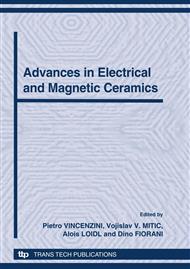[1]
H. Bordeneuve, C. Tenailleau, S. Guillemet-Fritsch, R. Smith, E. Suard and A. Rousset: Solid State Sci. Vol. 12 (2010), p.379.
DOI: 10.1016/j.solidstatesciences.2009.11.018
Google Scholar
[2]
A. S. Borovik-Romanov, M. P. Orlova: Soviet Physics-JETP Vol. 5 (1957), p.1023.
Google Scholar
[3]
V. Baron, J. Gutzmer, H. Rundolf, R. Tellgren: Am. Mineral. Vol. 83 (1998), p.786.
Google Scholar
[4]
W. L. Roth: J. Phys. Chem. Solids Vol. 25 (1964), p.1.
Google Scholar
[5]
E. W. Gorter: Philips Research Reports Vol. 9 (1954), p.295.
Google Scholar
[6]
A. Navrotsky, O. J. Kleppa: J. Inorg. Nuclear Chem. Vol. 29 (1967), p.2701.
Google Scholar
[7]
J. S. Griffith: The theory of transition-metal ions. Cambridge University Press (1961).
Google Scholar
[8]
W. L. Roth : Journal de Physique Vol. 25 (1964), p.507.
Google Scholar
[9]
B. Boucher, R. Buhl, R. Di Bella, M. Perrin : Journal de Physique Vol. 31 (1970), p.113.
Google Scholar
[10]
S. Tamura : Physica B Vol. 190 (1993), p.150.
Google Scholar
[11]
H. Bordeneuve, S. Guillemet-Fritsch, A. Rousset, S. Schuurman, V. Poulain : J. Solid State Chem. Vol. 182 (2009), p.396.
DOI: 10.1016/j.jssc.2008.11.004
Google Scholar
[12]
H. Bordeneuve, A. Rousset, C. Tenailleau and S. Guillemet-Fritsch : J. Therm. Anal. Calorim., DOI: 10. 1007/s10973-009-0557-7.
Google Scholar
[13]
E. Rios, O. Pena, T. Guizouarn and J.L. Gautier: Phys. Stat. Sol. C DOI : 10. 1002/pssc. 200304888.
Google Scholar
[14]
H.T. Zhang and X.H. Chen : Nanotechnology Vol. 17 (2006), p.1384.
Google Scholar
[15]
C. Campos, G. Pecchi, Y. Moreno, C. Moure, V. Gil, P. Barahona and O. Pena: Bol. Soc. Esp. Ceram. Vol. 47 (2008), p.207.
Google Scholar
[16]
M. Marysko, Z. Jirak, K. Knizek and C. Autret-Lambert: J. Mag. Mag. Mater. Vol. 322 (2010), p.1392.
Google Scholar
[17]
D. G. Wickham and W. J. Croft: J. Phys. Chem. Solids Vol. 7 (1958), p.351.
Google Scholar
[18]
A. Michel : Phénomènes magnétiques et structure. Paris, Masson et Cie (1966).
Google Scholar
[19]
P. Poix : Annales de Chimie, Paris Vol. 9 (1964), p.261.
Google Scholar
[20]
J. L. Baudour, F. Bouree, M. A. Fremy, R. Legros, A. Rousset, B. Gillot: Physica B Vol. 180 (1992), p.97.
DOI: 10.1016/0921-4526(92)90672-f
Google Scholar
[21]
B. Boucher, R. Buhl, M. Perrin: J. Appl. Phys. Vol. 40 (1969), p.1126.
Google Scholar
[22]
M. Beley, L. Padel, J. C. Bernier: Annales de Chimie Vol. 3 (1978), p.429.
Google Scholar


